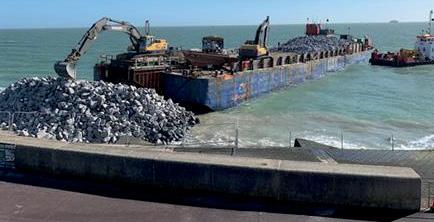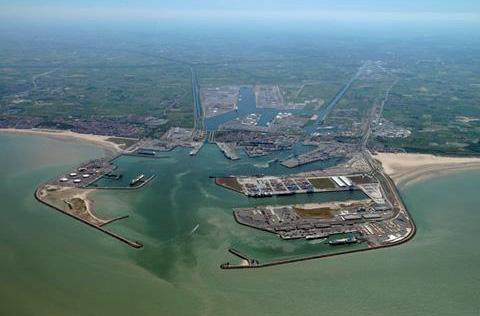
3 minute read
Flood defence
ROCK ARRIVES FROM NORWAY FOR SOUTHSEA FLOOD DEFENCE
Super dense rock from Norway is being shipped to Southsea for major fl ood defence work
Thousands of tonnes of rock have begun to arrive on the beach at Southsea as part of major fl ood defence works that will stretch 4.5km along the south coast of England.
The £130 million (€156 million) work, funded by central government, is being done in a joint venture between Boskalis Westminster and engineering contractor Volkerstevin (VSBW).
A total of 140,000 tonnes of rock will be shipped to the coast from Norway over the two years that the work is expected to take.
“The rock used in the flood defence has to meet specifications ensuring it will last for at least 100 years; the granite we use has to be very dense and very durable, plus procuring it has to be economically viable,” said customer engagement officer Jeannette Moyse.
“The granite we are using from Norway best meets all our requirements, and although there may be granite rock closer it may not meet the specifications for performance that the flood defences need.”
The rock is delivered by coaster to the shore and stockpiled for access during the work, which is of course tidal dependent. A working platform is built out to sea, and long-arm excavators place geotextile material as a base for the rocks to be placed on to maintain stability.
Smaller rocks are then moved into position as a core, with larger rocks, each weighing about four tonnes, placed on top in a way that they interlock and cannot move.
The work is currently being carried out along a stretch of coast where in February 2014 a storm damaged sea walls. In 2016 there was significant flooding during the so-called ‘Storm Angus’. These areas will be protected by a 600m stretch of ‘rock armour’ that will go out to sea for about 35 metres, Moyse said.
“The impact of global warming and climate increases the flood risk at Portsmouth, which is low lying, and as a result, rising sea levels are a cause for concern,” said Moyse. “Also climate change does result in more frequent and stronger storm events, further increasing the chance of flood events.”
Boskalis has also been contracted to carry out protection and replenishment works along 40km of coast from Togo to Benin in West Africa.
Fifteen groynes will be installed and six existing ones refurbished, and 1 million m3 of sand will be deposited along the coastline.
8 Southsea
fl ood defence engineering
Partnership fosters LNG ambitions
The Port of Zeebrugge has joined SEALNG, the multi-sector coalition created to promote LNG as a marine fuel.
The partnership highlights the need for collaboration between ports and other key players to ensure that infrastructure enabling the use of renewable synthetic LNG is in place.
Peter Keller, chair of SEA-LNG, welcomed the Port of Zeebrugge on board. “We look forward to working with the port and its users to continue to drive the growth of environmentally-friendly LNG-fuelled shipping in northwest Europe, creating a pathway for long term decarbonisation of the industry,” he said.
Infrastructure for storing and transferring LNG has been installed and used at the Belgian port since 1987 and the world’s first purpose-built LNG bunkering vessel – the Engie Zeebrugge (now Green Zeebrugge) – began operations there in June 2017.
With onsite storage of 9 billion cbm per year, the port’s LNG terminal, operated by Fluxys, offers regasification and provides distribution in Belgium and across the European network.
“Sustainability and climate protection are high on the agenda of the port authority of Zeebrugge,” said chief executive, Tom Hautekiet. “This new partnership with SEA-LNG will definitely offer us new opportunities to stimulate the switch to eco-friendly fuels and pursue our ambitions to become a green energy hub internationally.”

8 The Port of Zeebrugge






